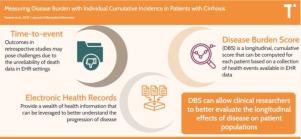测量肝硬化患者个体累积发病率的疾病负担。
IF 4.5
2区 医学
Q2 COMPUTER SCIENCE, INTERDISCIPLINARY APPLICATIONS
引用次数: 0
摘要
目的:介绍一种通过使用多类型复发事件数据来评估患者健康史的新方法,该方法可以帮助评估医疗机构的疾病进展和生活质量。方法:疾病负担评分(DBS)的特征是疾病负担曲线(DBC)下的面积,这是一个单调的、递增的逐步图,用于测量患者随访期间发生的加权或未加权的健康事件(即心血管事件或失代偿事件)。结果:我们的方法的性能,在模拟研究中进行了评估,表明我们的建模方法产生了公正的结果,并且可以在常见的生物医学研究环境中提高替代方案的能力。该方法还应用于电子健康记录收集的真实数据。结论:可以计算数据中所有患者的DBS,因此可以用作比较亚组的手段和回归的结果变量。这一措施不仅在没有死亡数据或没有可靠数据的情况下是一种有价值的工具,而且在死亡不频繁时也是一种临时措施。本文章由计算机程序翻译,如有差异,请以英文原文为准。

Measuring disease burden with individual cumulative incidence in patients with cirrhosis
Objective:
Introduce a new method for evaluating the health history of a patient through the use of multi-type recurrent events data that can aid in the assessment of disease progression and quality of life in a healthcare setting.
Methods:
The Disease Burden Score (DBS) is characterized as the area under the Disease Burden Curve (DBC), a monotone, increasing stepwise graph, that measures the weighted or unweighted number of health events that occur during a patient’s follow-up period (i.e. cardiovascular events or decompensation events).
Results:
The performance of our method, evaluated in simulation studies, demonstrated that our modeling method produces unbiased results and can improve power over alternatives in common biomedical research settings. The method was also applied to real data from a collection of Electronic Health Records.
Conclusion:
A DBS can be computed for all patients present in the data and thus can be used as a means of comparing subgroups and as the outcome variable in regression. This measure is not only a valuable tool in cases where death data is not available or reliable but also as an interim measurement when death is infrequent.
求助全文
通过发布文献求助,成功后即可免费获取论文全文。
去求助
来源期刊

Journal of Biomedical Informatics
医学-计算机:跨学科应用
CiteScore
8.90
自引率
6.70%
发文量
243
审稿时长
32 days
期刊介绍:
The Journal of Biomedical Informatics reflects a commitment to high-quality original research papers, reviews, and commentaries in the area of biomedical informatics methodology. Although we publish articles motivated by applications in the biomedical sciences (for example, clinical medicine, health care, population health, and translational bioinformatics), the journal emphasizes reports of new methodologies and techniques that have general applicability and that form the basis for the evolving science of biomedical informatics. Articles on medical devices; evaluations of implemented systems (including clinical trials of information technologies); or papers that provide insight into a biological process, a specific disease, or treatment options would generally be more suitable for publication in other venues. Papers on applications of signal processing and image analysis are often more suitable for biomedical engineering journals or other informatics journals, although we do publish papers that emphasize the information management and knowledge representation/modeling issues that arise in the storage and use of biological signals and images. System descriptions are welcome if they illustrate and substantiate the underlying methodology that is the principal focus of the report and an effort is made to address the generalizability and/or range of application of that methodology. Note also that, given the international nature of JBI, papers that deal with specific languages other than English, or with country-specific health systems or approaches, are acceptable for JBI only if they offer generalizable lessons that are relevant to the broad JBI readership, regardless of their country, language, culture, or health system.
 求助内容:
求助内容: 应助结果提醒方式:
应助结果提醒方式:


